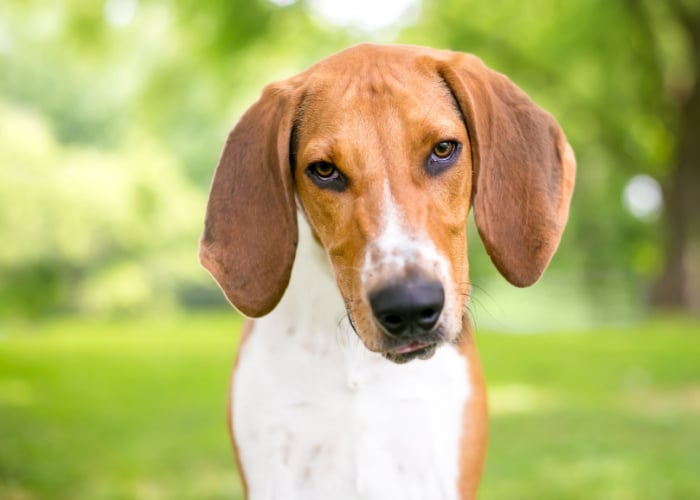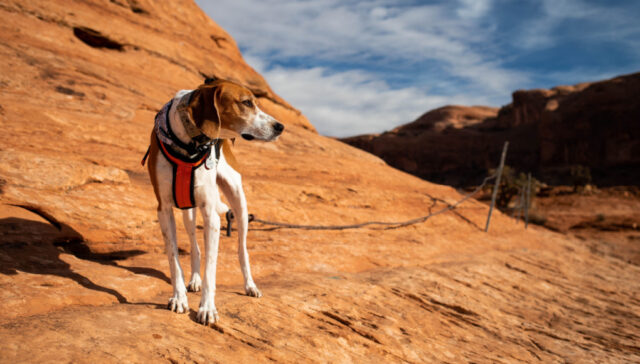
Table of Contents
- Halden Hound Dog Breed Profile: A Quick Glance
- The Haldenstøver Dog Personality Summary
- Living Conditions and Lifestyle of Halden Hound Dogs
- Questions to Ask Yourself Before Adopting a Haldenstøver Dog
- The Haldenstøver Dog Breed: Grooming, Diet, and Health
- The Halden Hound Dog: A Glimpse of the Past
- Halden Hound: Before You Go…
Dogs have 300 million scent receptors in their nose.
And according to experts from Phoenix Veterinary Center:
…the part of a dog's brain that is devoted to analyzing smells is about 40 times greater than ours.
While this ability comes off naturally, there’s a particular class of canines out there that excel in sniffing and scent-hunting activities.
Everyone… meet the Halden Hound!
To get to know this hound breed better, refer to the following information below:
- Physical traits and characteristics
- Personality
- Living conditions
- Grooming, diet, and health
- History
Let’s dive in!

Halden Hound Dog Breed Profile: A Quick Glance
What is a Halden Hound dog?
Also known as Haldenstøver in Norway, this medium-sized dog of the hunting hound class is a mixed breed between a Beagle and a variety of other European hounds.
Let’s take a closer look at Halden Hounds with this summary below:
| Weight | 40 to 55 pounds |
| Height | 17 to 21 inches |
| Lifespan | 12 to 15 years |
| Coat Length | Short to medium |
| Texture & Density | Straight, normal |
| Color | White, brown, black |
| Pattern | Spotted |
| Suitable for | Both hot and cold temperatures |
| Suitable Owner Profile | Active and experienced |
| Dog Breed Group | Hound; Working |
| Other Names | Haldenstøver, Halden |
| Recognition | United Kennel Club (2006) |
Physical Traits of the Halden Hound Dog
A mighty hound breed and adorable spotted pup wrapped into one?
Yup, the Halden pooch is living proof.
Get to know this scent-tracking dog with the following summary:
| Head | Domed, medium-length skull |
| Eyes | Medium-sized, dark brown with a tranquil expression |
| Ears | Long, folded, mid-set, spade-shaped |
| Muzzle | Medium-length |
| Nose | Black, wide-nostril |
| Neck | Long, strong |
| Shoulder | Well-muscled with straight, slightly humped topline |
| Chest | Deep, well-sprung |
| Body | Muscular |
| Feet | Sturdy, straight |
| Tail | Low-carried, thick, long, tapered |
Characteristics of the Halden Hound Dog
Well, if you consider the stubbornness of scent hounds, it must be difficult to own one.
However, the Halden Hounds—pretty much—are the tolerable kind.
Although well-mannered, affectionate, and loyal, Haldens still need an experienced owner who knows to exert authority in the household.
Because chances are, these hound dogs will easily push you to your limits and regard you as the obedient one.
So, to prevent that from happening, you might want to check on a few more things about them below:
| Energy Level | High |
| Activity Requirement | High |
| Drooling | Low |
| Shedding | Low |
| Affection Towards Owner | Loving |
| Temperament with Kids | Low, needs training and socialization |
| Friendliness to Strangers | Low, needs training and socialization |
| Compatibility with Other Dogs | Medium, needs training and socialization |
| Compatibility with Other Pets | Low, needs training and socialization |
| Trainability | Easy |
| Barking Tendency | Medium to high |
| Hypoallergenic | No |
Why are Halden Hound dogs non-hypoallergenic?
To cut to the chase, “no dog is 100% hypoallergenic” according to the American Kennel Club (AKC).
Even low-shedding and hairless dog breeds have dander, which causes allergic reactions in some people.
Note: Danders are dead skin cells.
Not just that, your dog’s saliva also causes allergies to sensitive hoomans.
However, besides the hairless ones, the most commonly regarded hypoallergenic dog breeds include:
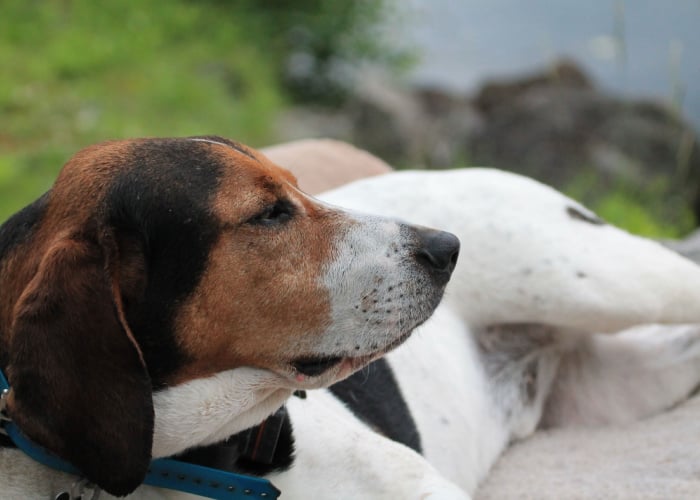
The Haldenstøver Dog Personality Summary
| Traits You’ll Love | Traits to Watch Out For |
| Affectionate | Prone to anxiety |
| Loves the outdoors | Can be very needy |
| Intelligent and easy to train | High barking tendencies |
| Well-mannered than other scent hounds | Needs an active and experienced owner |
Living Conditions and Lifestyle of Halden Hound Dogs
Are Halden Hounds good apartment dogs?
Halden Hound dogs are less suitable for apartment living due to their high activity requirements.
As hound dogs, Haldens love action even while staying inside your house, especially if you don’t give them attention.
Halden Hounds also need mental stimulation, so you’ll need interactive dog toys, too.
And one more thing, these scent hounds are born for the outdoors and their loudness can be a nuisance to your apartment neighbors.
Can Halden Hound dogs be left alone?
Halden Hounds should not be left alone, especially for long periods of time.
This scent hound’s level of affection and attachment to you as their owner can translate to episodes of aggression and anxiety.
So, when you’re running errands or going on business trips, be sure to have a familiar face pet sit your Halden Hounds at home.
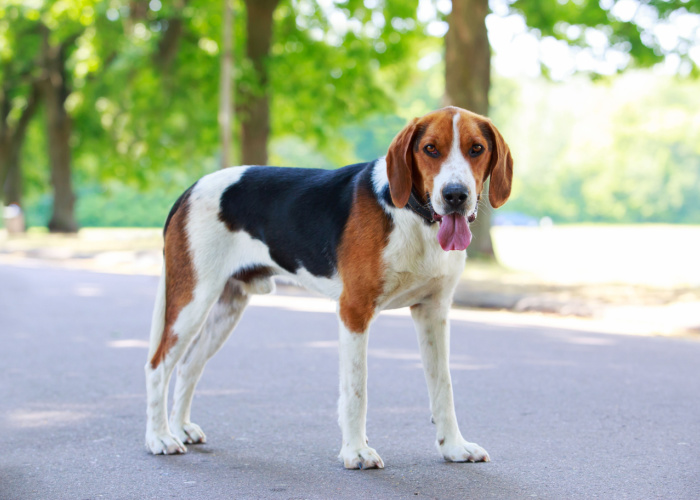
Questions to Ask Yourself Before Adopting a Haldenstøver Dog
Are Halden Hound dogs great family pets?
Halden Hounds can make great family pets because of their affectionate and loyal nature.
Especially when trained and socialized at an early age, you can rely on the Halden dog’s friendliness.
Be sure, however, to fulfill this scent hound’s need for daily exercise and a knack for adventure to prevent this active pup from getting bored.
Are Halden Hound dogs great pets for kids?
Halden Hound dogs can make great pets for kids.
However, it’s practical to keep an eye on your children when they’re around this hound dog.
It’s important to expose your Halden dogs to early training and socialization, too.
And adult members of the family should also lead the Halden Hound pack at all times to control their needy attitude.
Important: Halden Hound dogs are suitable for experienced owners.
Are Halden Hound dogs great around other pets?
Halden Hound dogs can make great companion animals around other pets if trained and socialized early.
That’s because scent hounds are notoriously known to be stubborn breeds.
So, hound owners should exert authority at home while being gentle and loving fur parents.
The Haldenstøver Dog Breed: Grooming, Diet, and Health
Halden Hounds are low-shedders, but they need proper hygienic care, too.
You might want to invest in some pretty good de-shedding brushes and grooming tools for your scent-obsessed pooch.
For your reference, here’s a table of grooming essentials for your Haldenstøver dogs:
Grooming a Halden Hound Dog
| Grooming Essentials | Frequency |
| Bathing | Occasional or depending on exposure to dirt |
| Nail Trimming | 1x per month |
| Ear Cleaning | Weekly |
| Teerth Brushing | Daily |
The Halden Hound Diet
As a general rule of thumb, feeding your dogs needs to be proportionate to their size.
So, for your Khala dogs at home, be sure not to overfeed them to avoid obesity-related diseases.
Much better if you seek your vet’s advice on what type of diet they need.
Your vets will balance their daily food requirements to the following criteria:
- Weight
- Energy level
- Medical history
Also, be sure to slow down on giving your beloved hairless furballs too much sweet treats.
Or for a healthier approach, you can give fruit and veggie slices to your Khala dogs occasionally.
The Health of a Halden Hound Dog
The Haldenstøver dog can live a long, healthy life with a proper diet and adequate living conditions.
But take note—dogs can inherit their parent’s genetic illnesses or acquire diseases in the long run.
So, it’s best to take note of the following conditions for your awareness:
Canine Hip Dysplasia
Also known as CHD, canine hip dysplasia is a skeletal disorder in dogs that targets the ball and socket joint in the hip.
While CHD is common in small-breed dogs, the Halden Hound dog is also prone to this condition.
This bone disorder is commonly caused by the following factors:
- Lack of exercise
- Improper nutrition
- Bone formation process
If you’re suspecting CHD in your Haldenstøver dogs, then watch out for the following symptoms:
- Limping
- Weakness
- Hind leg pain
- Difficulty moving
Meanwhile, veterinary experts make continuous efforts to look for treatments for CHD.
But, the following are known to relieve joint pain in dogs with CHD according to a study:
- Fish oil
- Green-lipped mussels
- Nonsteroidal anti-inflammatory drugs
- Polysulfated glycosaminoglycan supplements
Note: Numerous studies confirm that maintaining a healthy body weight helps prevent or delay hip dysplasia in dogs.
Ear Infections
“Dogs with long, heavy ears seem predisposed to chronic ear infections that can lead to otitis interna.” – VCA Animal Hospitals
Otitis internal, or inner ear infection, is commonly caused by bacteria and yeast.
Other related conditions like ear mites infestation in the outer canal can also contribute to this infection.
While this ear infection is common in dogs with long ears (Spaniel and Hound breeds), other canines can be vulnerable to this condition, too.
Especially when the eardrum is damaged, the inflammation can worsen in the inner part of the ear.
Note: Excessive cleaning can also cause damage to your dog’s eardrum.
So, what are the signs of ostitis interna in dogs?
- Hearing loss
- Loss of balance
- Difficulty walking
- Head shaking or tilting
- Pawing on the affected ear
- Foul-smelling ear discharge
- Pain when chewing or opening the mouth
For treatments, take note of the following vet procedures:
- Surgery
- Antibiotics
- IV Fluid therapy
- Anti-fungal medication
Important: If your Haldenstøver dogs have severe ear infections, pay attention to the following:
- Prevent access to stairs
- Hand-feed if they feel nauseated
- Limit movements during treatment
Hunting Injuries
“Herding and hunting dogs are intense, high-drive dogs that work, and often live, outdoors and in constant or repeated close contact with domestic and wild animals.” (Source)
Cuts, being the most common injury in hunting dogs, can be due to the following elements:
- Briars
- Barbed-wire
- Broken glass
- Thorny or spiky plants
- Sharp, broken saplings
To help reduce injury healing time, take note of these watchwords: flush, fill, and wrap.
What to do?
Step 1: Flush the fresh wound with clean fluid (distilled water or sterile saline solution) using a spray bottle.
Step 2: Use gentle pressure in spraying on the wound to get rid of small debris.
Step 3: Blot the area dry with a clean surgical sponge after flushing.
Step 4: Fill the wound with a good-quality gel (K-Y Jelly, EMT Gel, Collasate) which works as a barrier to hair and other external factors.
Step 5: Cover non-bleeding wounds with a simple bandage.
For bleeding wounds, putting direct pressure on your hand for 5-8 minutes or a snug bandage is the best way to stop bleeding.
Severe bleeding, on the other hand, needs a blood-stopping pressure bandage.
Or keep your hand in place until your dog receives professional care.
Important: Avoid placing dry cotton bandage material directly on the wound, especially for long periods.
This is to prevent clots from bleeding again once the material is removed.
Degenerative Myelopathy
According to experts from Cornell University, degenerative myelopathy (DM) is a disease that affects the spinal cord in dogs.
This condition, unfortunately, leads your dog to an inability to walk after 6 to 12 months.
DM in most dog breeds is caused by a mutation in the SOD1 gene (SOD1A variant).
Halden Hounds that suffer from DM are characterized by an inherited neurologic disease that occurs when they reach 8 years old or older.
While signs can differ in your dogs, DM typically starts in one hind limb and then progresses to include both.
Which, later on, includes the following symptoms::
- Muscle loss
- Incoordination
- Difficulty rising
- Hind limb weakness
- Scuffed toenails on hind limbs
Note: There is no cure for DM.
But caring for your pup suffering from this disease includes the following:
- Keep a healthy weight
- Regular physical therapy
- Add pet ramps or steps where needed
- Let them wear booties to decrease paw damage
- Consider using a wheelchair to support the hind limbs
- Use a sling or harness to assist with walking and standing
- Put rugs, carpets, or yoga mats on hardwood or tiled surfaces
Important: Pay attention to other underlying conditions in your dogs that can trigger or worsen DM, like arthritis and overall bone health.
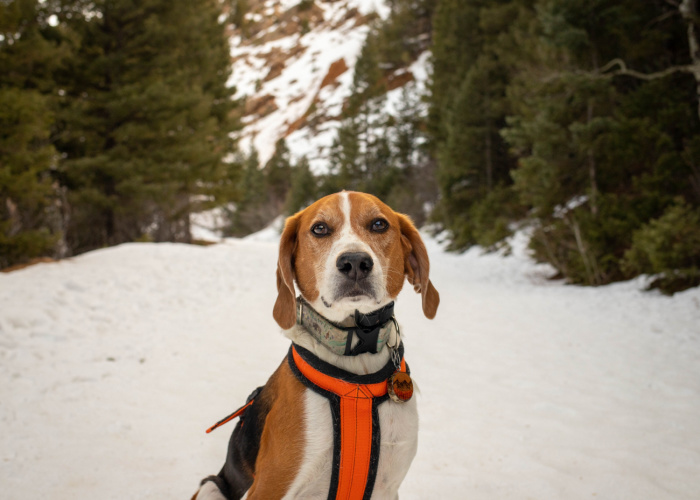
The Halden Hound Dog: A Glimpse of the Past
| Origin | Norway |
| Year | 1900s |
| Bred as | A working dog that hunts Norwegian hares
Trivia: They prefer hunting alone than in packs. |
| Significant deets | The name Halden is derived from their place of origin — a town in southeastern Norway that borders Sweden |
Are Halden Hound dogs rare?
The Halden Hound dog is a rare canine breed due to threats (war, disease outbreaks) even from its early development.
Haldenstøver dogs are also regarded as nearly extinct with only a few pups registered in their native land in Norway and none internationally. (Source)
You may find this hound breed outside of Norway, but it can take time and a long-distance trip is a looming possibility.
Halden Hound: Before You Go…
If you’re going to ask me which dog breed is the best…
For a dog lover like me, that’s impossible to answer.
That’s because dogs have their individual unique traits and personality.
And it’s good to note that dog owners have their unique preferences, too.
So, I’ll recommend going for pups that complete you emotionally.
Trust me—there’s that one furball that will make you happy fur-ever.
Enjoyed this blog? Read our top picks below!


